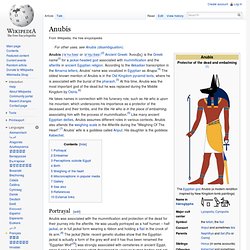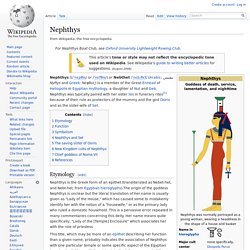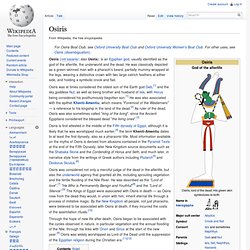

Anubis. Anubis (/əˈnuːbəs/ or /əˈnjuːbəs/;[2] Ancient Greek: Ἄνουβις) is the Greek name[3] for a jackal-headed god associated with mummification and the afterlife in ancient Egyptian religion.

According to the Akkadian transcription in the Amarna letters, Anubis' name was vocalized in Egyptian as Anapa.[4] The oldest known mention of Anubis is in the Old Kingdom pyramid texts, where he is associated with the burial of the pharaoh.[5] At this time, Anubis was the most important god of the dead but he was replaced during the Middle Kingdom by Osiris.[6] He takes names in connection with his funerary role, such as He who is upon his mountain, which underscores his importance as a protector of the deceased and their tombs, and the title He who is in the place of embalming, associating him with the process of mummification.[5] Like many ancient Egyptian deities, Anubis assumes different roles in various contexts. Portrayal[edit] Embalmer[edit] Perceptions outside Egypt[edit] Birth[edit] Gallery[edit]
Nephthys. Etymology[edit] Nephthys - Musée du Louvre, Paris, France Nephthys is the Greek form of an epithet (transliterated as Nebet-het, and Nebt-het, from Egyptian hieroglyphs).The origin of the goddess Nephthys is unclear but the literal translation of her name is usually given as "Lady of the House," which has caused some to mistakenly identify her with the notion of a "housewife," or as the primary lady who ruled a domestic household.

This is a pervasive error repeated in many commentaries concerning this deity. Her name means quite specifically, "Lady of the [Temple] Enclosure" which associates her with the role of priestess. Function[edit] Nephthys was known in some ancient Egyptian temple theologies and cosmologies as the "Useful Goddess" or the "Excellent Goddess".[2] These late Ancient Egyptian temple texts describe a goddess who represented divine assistance and protective guardianship. Triad of Isis, Nephthys, and Harpocrates. Pyramid Text Utterance 222 line 210.[11] Ogbunabali. Osiris. Osiris (/oʊˈsaɪərɨs/; also Usiris), is an Egyptian god, usually identified as the god of the afterlife, the underworld and the dead.

He was classically depicted as a green-skinned man with a pharaoh's beard, partially mummy-wrapped at the legs, wearing a distinctive crown with two large ostrich feathers at either side, and holding a symbolic crook and flail. Osiris is first attested in the middle of the Fifth dynasty of Egypt, although it is likely that he was worshipped much earlier;[4] the term Khenti-Amentiu dates to at least the first dynasty, also as a pharaonic title.
Most information available on the myths of Osiris is derived from allusions contained in the Pyramid Texts at the end of the Fifth Dynasty, later New Kingdom source documents such as the Shabaka Stone and the Contending of Horus and Seth, and much later, in narrative style from the writings of Greek authors including Plutarch[5] and Diodorus Siculus.[6]